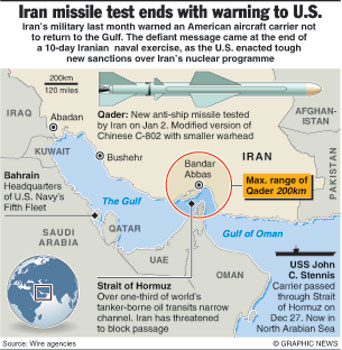If you are not prepared to go to war, you cannot threaten that "nothing is off the table" as you search for diplomatic solutions.
Thus there are completed plans, updated daily, at Israeli military headquarters in Tel Aviv and at the Pentagon for carrying out attacks on Iranian facilities in a last-ditch effort to prevent Tehran from acquiring a nuclear weapon.
Israel has a plan to go it alone. So does the United States. And there may even be a plan for the two countries to collaborate. On Dec. 20, the Joint Chiefs chairman, Gen. Martin Dempsey, told CNN: "We are examining a range of options" and "I am satisfied that the options that we are developing are evolving to a point that they would be executable if necessary."
In any event, the plans exist, and they illustrate the difficulties in carrying out what some people think would be a simple operation.
For example, should Israel act alone, it would face the extraordinary problem of needing to refuel its bombers en route to targets about 1,000 miles away and refueling them again on the way back. That is why in the new Bipartisan Policy Center report, "Meeting the Challenge: Stopping the Clock," former senator Charles S. Robb (D-Va.) and retired Air Force Gen. Charles F. Wald suggest that the United States provide Israel with three KC-135 refueling tankers.
Robb and Wald do not advocate that the Israelis undertake such an attack, but they say that providing the tankers would "extend the effective range of Israeli aircraft" and "improve Israeli credibility."
Then there are questions about what targets should be hit, and how many planes would be needed, to stop Iran's nuclear programme, even temporarily. Israel's two past successes hardly count.
When Israel knocked out Iraq's Osirak nuclear reactor in June 1981, it was essentially one ground-level building, yet the mission required 14 Israeli aircraft - F-16 fighter-bombers with some of their fuel tanks removed to carry heavy bombs, and F-15 fighters to handle any Iraqi planes that came up to meet them. Israel's other success, hitting a partially constructed Syrian facility in September 2007, again targeted a single, ground-level building.
Now look at the potential targets in today's Iran.
There is the fuel-enrichment plant at Natanz, a collection of below-ground facilities used to produce enriched uranium. There is the newer Fordow fuel-enrichment plant near Qom, built into the side of a mountain and heavily fortified. This is where Iran has already moved 3.5 percent enriched uranium from Natanz and where most analysts believe it will be enriched to weapons grade, if Tehran decides to take that step.
Of course there would be other targets if a strike is to do more than set back Iran by one to three years. At Parchin, one of the nation's leading munitions centers, Iran is suspected of testing high explosives for use in nuclear weapons, according to the International Atomic Energy Agency's November report. There is a uranium conversion plant at Isfahan, a heavy-water facility being constructed at Arak and centrifuge factories outside Tehran.
No telling how many aircraft the Israelis would need to carry out a meaningful mission. The Robb-Wald report says Israel has enough GBU-28 bunker-busting bombs to "severely damage, though likely not completely destroy, Iran's known underground nuclear sites in a single well-executed operation."
How Israel would or could deal with Iran's response to such an attack is anyone's guess.
U.S. planning takes Iran's reaction into consideration. As one former Pentagon official said, "Pentagon planning considers hitting targets and defending against retaliation."
The Robb-Wald report, put together by a task force that includes former military commanders, outlines just part of "what U.S. military action would look like," in its words. The target list, beyond Iran's nuclear facilities, would include communications systems; air defence and missile sites; Revolutionary Guard Corps facilities; munitions storage facilities, including those for sea mines (remember the Strait of Hormuz); airfields and aircraft facilities; and ship and port facilities, including midget submarines, missile boats and minelayers.
Aircraft employed would include B-2 stealth and B-52 bombers, fighter-bombers and helicopters, along with ship-launched cruise missiles. "Special Forces and intelligence personnel already in-theatre can easily move to protect key assets or perform covert operations," according to the report.
Remember that these plans are needed to make credible the threat that "nothing is off the table" - which in turn is designed to put muscle behind the diplomatic efforts. And those new sanctions, particularly cutting off Iran's oil sales, are being pursued with effect.
Just this week, the United States continued pressuring India to reduce its oil purchases from Iran. State Department spokesman Victoria Nuland told reporters Tuesday that talks in Washington with Indian Foreign Secretary Ranjan Mathai included "how India might find alternative sources. .?.?. This is a two-track policy, both to encourage countries to wean themselves from Iranian oil, but also to work with suppliers around the world to help countries find alternative sources of supply."
In his pre-Super Bowl interview on NBC last Sunday, President Obama said, "Our preferred solution here is diplomatic; we're going to keep on pushing on that front. But .?.?. I've been very clear that we're going to do everything we can to prevent Iran from getting a nuclear weapon and creating an arms race, a nuclear arms race, in a volatile region."
He preceded that statement with the familiar "We're not going to take any options off the table" - and now you have some idea of what that means.
Courtesy washingtonpost.com |


